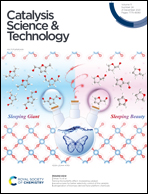The degradation of phenol via in situ H2O2 production over supported Pd-based catalysts†
Abstract
The oxidative degradation of phenol via the in situ production of H2O2 from molecular H2 and O2 offers an attractive route to the destruction of organic contaminants in water streams, potentially overcoming the significant economic and environmental concerns associated with traditional water remediation technologies. Herein we demonstrate the efficacy of a series of bifunctional Pd-based catalysts, which offer appreciable rates of phenol degradation. In particular, the introduction of Fe into a supported Pd catalyst leads to a near four-fold increase in pollutant remediation. We ascribe this improvement in catalytic performance to the ability of Fe to catalyse the formation of oxygen-based radical species from in situ synthesised H2O2via Fenton's pathways and the promotion of Pd domains of mixed oxidation state, with a resulting inhibition of H2O2 degradation pathways.



 Please wait while we load your content...
Please wait while we load your content...